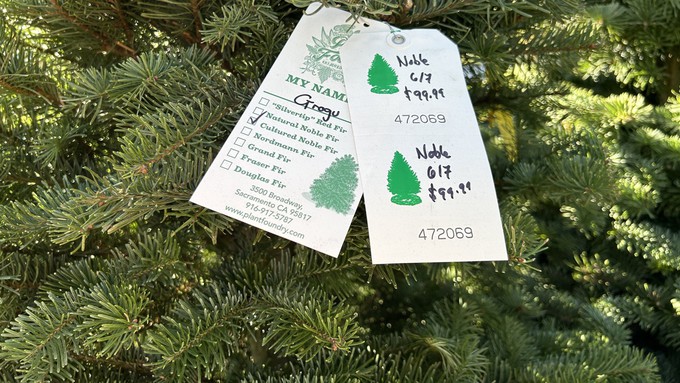
Whether cut or potted, these tips will help your evergreen stay fresh

Someone who shopped at The Plant Foundry snagged a tree named after Grogu, the "baby Yoda" from "The Mandalorian." Keeping it as green as its (shorter) namesake requires watering and proper placement. Kathy Morrison
How do you help your Christmas tree stay healthy, merry and green?
According to the National Christmas Tree Association, the answer is water.
Make sure your real tree has its trunk in a sturdy stand that can hold plenty of clean water. Check the water every day and replenish as necessary so the tree is standing in at least 2 inches of water.
Firs and other popular Christmas trees need about 1 quart of water per inch of trunk diameter, says the association.
And keep the water clean; added preservatives and home remedies such as aspirin, bleach, corn syrup or sugar have little impact on extending the tree’s freshness.
Daily watering is important, say the experts. If the trunk dries out, resin forms that can block the uptake of more water – and the tree dries out much sooner.
Keeping the stand’s basin full should help the tree – which likely was harvested before Thanksgiving – hold its needles through Dec. 25. Holiday evergreens stay fresh looking and hold their needles about four to six weeks after harvest, says the association.
Position your real tree away from windows or heater vents; both light and heat prompt the tree to need more moisture. It will last longer in a cool corner.
What about potted living Christmas trees? They have to have a spot next to a sunny window and as much light as possible. Because these trees really don’t like being in your living room and want outside ASAP.
Give the tree as much light as possible, but keep it away from heat. It doesn’t want a spot next to the heater, either.
Although a potted tree is appealing (it’s reusable!), evergreens aren’t meant to grow indoors; there’s not enough light. Once your celebrating is done, get your tree or other potted evergreens outdoors as soon as possible to limit their stress. Otherwise, they’ll start dropping needles en masse – just like a cut tree without water.
While it’s indoors, make sure the living tree stays watered. Keep the soil moist, not soggy. Check the soil moisture daily and remember that 1 quart per inch of trunk diameter guideline.
When transferring outdoors, move the plant back into full sun gradually. Let it acclimate on a semi-shaded patio for a few days as the tree re-adjusts to outside temperatures and light. The shock of cold temperatures and full sun may be too much – and your living Christmas tree won’t be around for next year.
Comments
0 comments have been posted.Sacramento Digs Gardening to your inbox.
Sites We Like
Garden Checklist for week of July 21
Your garden needs you!
* Keep your vegetable garden watered, mulched and weeded. Water before 8 a.m. to reduce the chance of fungal infection and to conserve moisture.
* Feed vegetable plants bone meal, rock phosphate or other fertilizers high in phosphate to stimulate more blooms and fruiting. (But wait until daily high temperatures drop out of the 100s.)
* Don’t let tomatoes wilt or dry out completely. Give tomatoes a deep watering two to three times a week.
* Harvest vegetables promptly to encourage plants to produce more. Squash especially tends to grow rapidly in hot weather. Keep an eye on zucchini.
* Pinch back chrysanthemums for bushy plants and more flowers in September.
* Remove spent flowers from roses, daylilies and other bloomers as they finish flowering.
* Pinch off blooms from basil so the plant will grow more leaves.
* Cut back lavender after flowering to promote a second bloom.
* It's not too late to add a splash of color. Plant petunias, snapdragons, zinnias and marigolds.
* From seed, plant corn, pumpkins, radishes, winter squash and sunflowers.